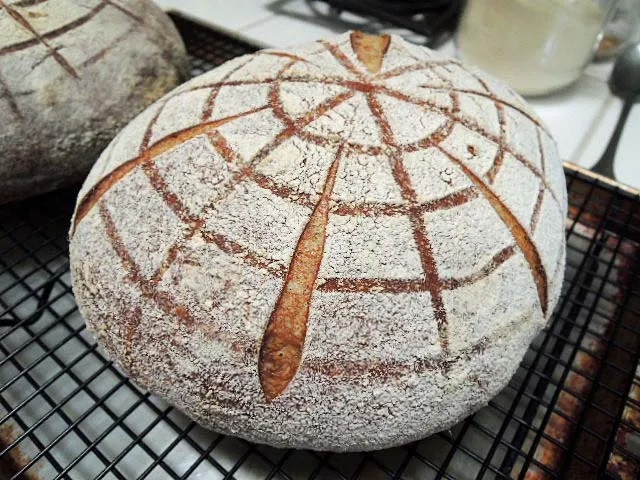
San Francisco-style Sourdough Bread with Increased Whole Wheat
by David M. Snyder
May 5, 2013
Sometimes another TFL member comments favorably on one of my breads, then goes on to say how they have modified my formula or methods. Sometimes these changes seem to be for the member's convenience or to substitute a preferred method for the one I used. Sometimes I feel the changes are of small consequence. The one alteration that consistently intrigues me is an increase in whole grains in a formula of mine that is basically a white bread.
Today, I baked a couple loaves of my San Francisco-style Sourdough Bread with two modifications: I increased the whole wheat content to 30% of the total flour, and I increased the hydration to 76%. I expected this increase in hydration to more than compensate for the increased water absorption of the whole wheat flour. I used a very finely milled organic whole wheat flour from Giusti's. I find this flour has much less cutting of gluten strands than most whole wheat flours. I can get a more open crumb using this flour.
I also made a couple loaves of the San Francisco-style Sourdough without the increased whole wheat.
Total dough | Bakers' % | Wt (g) |
AP flour | 54 | 304 |
Bread flour | 14 | 79 |
Medium Rye flour | 2 | 11 |
WW Flour | 30 | 169 |
Water | 76 | 428 |
Salt | 1.9 | 11 |
Total | 177.9 | 1002 |
Stiff levain | Bakers' % | Wt (g) |
Bread flour | 95 | 79 |
Medium rye flour | 5 | 11 |
Water | 50 | 45 |
Stiff starter | 80 | 66 |
Total | 230 | 201 |
Dissolve the starter in the water. Add the flours and mix thoroughly until the flour has been completely incorporated and moistened.
Ferment at room temperature 6-8 hours. (Until about tripled in volume, domed and very well aerated.)
Final dough | Wt (g) |
AP flour | 281 |
WW Flour | 162 |
Water | 350 |
Salt | 11 |
Stiff levain | 201 |
Total | 1005 |
Method
In a stand mixer, mix the flour and water at low speed until it forms a shaggy mass.
Cover and autolyse for 30 minutes
Add the salt and levain and mix at low speed for 1-2 minutes, then increase the speed to medium (Speed 2 in a KitchenAid) and mix for 5 minutes. Add flour and water as needed. The dough should be rather slack. It should clean the sides of the bowl but not the bottom.
Transfer to a lightly floured board and do a stretch and fold and form a ball.
Place the dough in a lightly oiled bowl and cover tightly.
Ferment at 76º F for 21/2 to 3 hours with a stretch and fold at 50 and 100 minutes.
Divide the dough into two equal pieces.
Pre-shape as rounds and rest, covered, for 10 minutes.
Shape as boules or bâtards and place in bannetons. Place bannetons in plastic bags.
Proof at room temperature (68-70º F) for 1-2 hours.
Cold retard the loaves overnight.
The next morning, proof the loaves at 85º F for 2 to 3 hours. (If you can't create a moist, 85 degree F environment, at least try to create one warmer than “room temperature.”
45-60 minutes before baking, pre-heat the oven to 480º F with a baking stone and steaming apparatus in place.
Transfer the loaves to a peel. Score the loaves as desired, turn down the oven to 460º F, steam the oven, and transfer the loaves to the baking stone.
After 12 minutes, remove the steaming apparatus, and turn down the oven to 435º F/Convection. (If you don't have a convection oven, leave the temperature at 460º F.)
Bake for another 15-18 minutes.
Transfer the loaves to a cooling rack, and cool thoroughly before slicing.
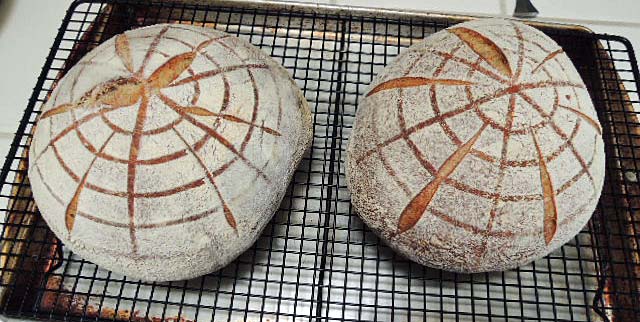
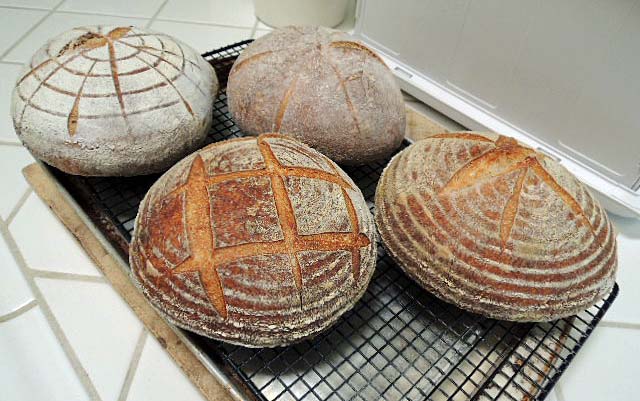
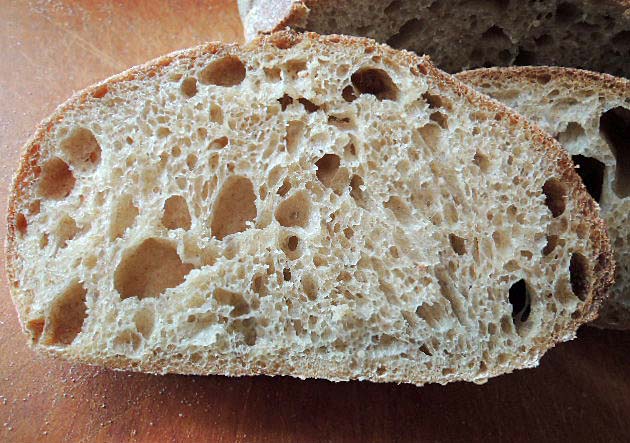
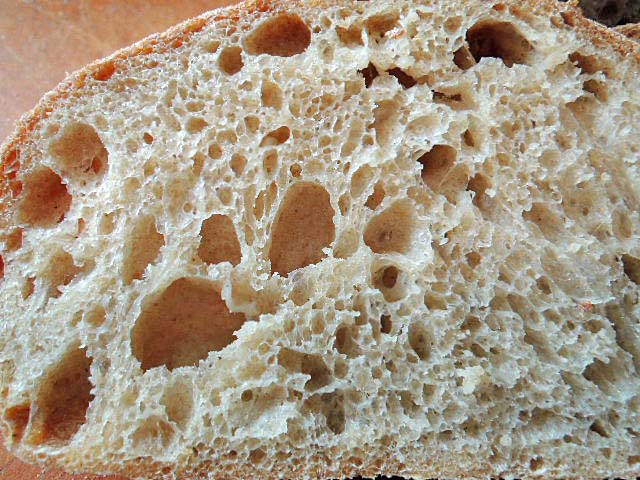
After cooling, the loaves had a chewy crust and chewy crumb. The flavor was wheaty and moderately sour when first tasted. I am looking forward to trying this bread toasted tomorrow for breakfast.
At the moment, I am considering further modifications such as a bolder bake, adding a bit of honey and increasing the whole wheat to 50%.
David
- dmsnyder's Blog
- Log in or register to post comments
Very nice looking loaves.
David
Hi David,
I'm thinking you probably know more about San Francisco Sourdough than most people here on TFL. I also understood it to be a white bread. Your version here is of far greater interest to me of course; we virtually never eat white bread in our home of any kind.
Anyway, wonderful bread, as always; bold and cut and dusted perfectly
All good wishes
Andy
You are correct. At least the "San Francisco Sourdough" I grew up on was a very sour, very white bread. Today, many of the best (my opinion) sourdough breads made in San Francisco are less sour and clearly have some whole grain content.
There is no statutory definition of San Francisco Sourdough, and my interest is less in duplicating a model than in making good bread. So, I will continue to experiment.
Thanks for your kind remarks.
Best regards,
David
Beautiful, beautiful boules David!
A healthier version no doubt. Your Guisto whole wheat flour seems to be of excellent quality. Why don't you add diastatic malt (1/2 tsp per loaf) ? It would add a subtle sweet flavor.
-Khalid
I am thinking of adding a mild-flavored honey, but malt is another interesting option. Thanks for the suggestion.
David
Really nice crumb David. Sure didn't expect it to be that open with 30% wheat. I'd like to see the variation of this loaf building the levain with wheat and having less wheat and more white flour in the final dough. I may have to give this a try.
Nice Baking
Josh
I've thought about increasing the WW in the levain, too. I've also thought about using a mixed grain/seed soaker. So many options!
Both Giusto's and Central Milling mill whole wheat flours that have very fine-ground bran. I have used this type of flour for 100% whole wheat breads, and the crumb structure is really different from when the same bread is made with coarser WW flour.
David
I use Giustos Hard Red Winter Wheat. But we grind in house and probably not as fine as they do. There wheat in the last year has had a huge change. It started sucking up so much more water that I had to adjust my recipes to suit. How does Central Mills Flours compare to Giustos?
Instead of honey wheat, which I'm sure you've had countless times. Puree some carmelized onions and throw them in the mix. Caramelized onion whole wheat sour sounds nice. Anyhow nice baking as always David
Josh
Comparing their respective fine-milled WW flours, I can't say I can tell the difference. In fact, it would not surprise me to find that they are, in fact, the same product.
David
- well sort of. I went to a brewing supply store and got some dark malt syrup (non-diastatic, of course). It has been an intriguing addition to quite a few formulas. You might want to give it a try...
Nice bread!
Pat
Another comment on non-diastatic malt....
I just ordered some powdered nd malt from KA this morning. I generally add a bit (.5%) to a lot of the loaves I bake along with honey. Not sure why I do it but one of the books I get a lot of my formulas out of got me in the habit and I get good results so I persist :- )
I used to use the syrup but that stuff is sooooo sticky it leaves long strands of itself all over everything....like spider webs. The powder is better behaved but must be kept DRY or it turns to stone. :0 )
Khalid: The 'non-diastatic malt' adds the sweetness whereas the 'diastatic' doesn't have the same effect and can make loaves gummy if added in to large of a quantity. It is used more as food for the yeast when long fermentations can eat up all the sugars making the final loaf a bit pale in color. At least that is what I have been told when I have asked about the differences in the past. It does tend to get confusing so maybe I am still confused but I thought I woudl toss in my 2¢ worth :- )
Janet
You are right, janet. I must have confused the mash with the diastatic malt, which also contains diastatic malt. Mashing a paste of dough with diastatic malt frees up sugars like crazy. I paraphrase Peter Reinhart saying it in his book Whole grain breads : "being very sweet, as if there was honey in there".
So, yeah although it doesn't add sweetness outside of a mash, diastatic malt does impart a lovely flavor and colors the crust very nice. I havn't used non-diastatic malt, though, so can't judge their role in bread.
-Khalid
Hi Khalid,
PR is where I first read about malts too when I made the mash loaf :- ) It is a nice one.
If you want to give non diastatic malt a try just take some of your diastatic malt and bake it at a temp. high enough to kill off the enzymes. Just watch that you don't don't scorch it or you get a whole different taste profile.
Take Care,
Janet
P.S. DAVID: DIdn't mean to hi-jack here. It just happened and now it is done and back to you. Sorry. :- (
Hi David,
Super looking crumb on your loaves considering 30% WW, and as always the colour of your loaves are top notch!
The Giustos flour must be quite fine to render such an open celled crumb and I'd love to find something similar in my neck of the woods. Adding honey to a sourdough has worked well for me with several types of sourdough, with the contrast in flavours making the taste more complex as well as helping to keep it moister for a longer period of time.
The dusting cage that I'm guessing was used for 2 of your loaves is something I've been looking for since seeing it in your SFBI Artisan 1 post a couple of years ago.The pattern is very clean looking, and I like the simplicity of it over using a brotform, especially for high hydration doughs. Is it something that TMB carries,or would you mind sharing your source for where you found it? Nice baking David, all the best!
Franko
Thanks for your kind words!
The flour pattern is created by dusting the loaves with flour through a fine sieve while a circular wire cooling rack is balanced on them. TMB did have them in their catalogue. At the time I ordered, they were out of stock. After several months, I looked elsewhere. Here is a link to the one I think I ended up with: Kaiser Bakeware Patisserie Cooling Rack, Silver, 12.5"
Re. fine WW flour: I believe the technique used is to first mill the wheat as usual. Then the separated bran is more finely milled and added back into the reconstituted "whole wheat" flour. i think a home miller could accomplish a similar product - Mill, sift, re-mill bran to very fine, etc. I speak from precisely no experience with this, of course. Maybe Pat or other serious home millers will chime in.
Best regards,
David
Thanks for the link David, appreciated!
one who changes your breads around. Not because the aren't great but because of health reasons and where I live. Today was cool and the kitchen was 85 F. If Lucy lef dough on the counter like you do it would be goo:-) Eric Hanner got me doing slap and folds and so now no cleaning of the mixer is required. The bread likes being slapped around in the beginning if followed by S&F's,t every 15 minutes for 3 of them and then in the fridge it has to go before it explodes.
My favorite white bread by far is this one with 30% whole grains split between spelt, www and rye, with a ww and rye sour starter. 70% white flour in the mix means it is still a white bread in my book and a darn good one too. Hope you like the darker side of your formula as much as I do,
The SFSD I remember from the late 60's early 70's was more sour and had more whole grains but those were hippy days and bread had more whole grain in it or it wasn't hip enough :-) Of course during the 1850's gold rush times, it was most likely all whole grains. I guess that is the real SFSD of old.
I like the red and white malts in these breads too. The bread tastes and browns better with them in the mix and the sweetness seems to comes though probably because the yeast can't eat all that food being made fast enough.
Very nice bread baking as usual David.
These loaves look they were pumped up with compressed air during the bake. Your proofing must have been perfect to avoid big splits at the score while getting that huge round shape. And very artistic decorating as well. I am another reader who has modified your recipes on several occasions, mostly adding whole grains, to try to eke out every bit of flavor the flours have to offer. I hope you enjoy the whole grains - I think they add another dimension to breads.
-Brad
You may have noticed, I modify my recipes too. LOL
By way of an update, in the past 3 days I have had this bread untoasted with almond butter, toasted with almond butter and jam, toasted with butter and untoasted in a braised brisket sandwich. It was delicious for all of these. I was most pleased by the crumb texture when toasted. It was very "light" and "crunchy." Really delightful.
The bread has been kept wrapped in plastic and has stayed quite moist. The flavor has mellowed and, to my taste, improved considerably. Not that it was bad before. It's just gotten better.
Thanks, everyone, for your suggestions. I have so many ideas about where I want to take this, I hardly know what variation to try next. Maybe rolls for sandwiches. Maybe with a multi-grain soaker. Maybe increase the WW and add honey or malt. Hmmmm ......
Happy baking!
David
Hi i love your recipe, i like to bake with a lot of whole wheat because i mill my own at home, and for the extra flavour it adds. My starter is kept at 100% hydration could i just add a small amount to the levain and still get good results.
Kristen
Oops. Sorry David, I didn't mean to post this here.
Hi David. I have a friend who came from San Francisco. She said that she misses SF sourdough bread very much since she moved to Australia and finds that sourdough bread made in Melbourne just doesn't taste the same. Last Saturday I baked 3 loaves of your recipe to bring over to her place when she invited my family over for dinner. I haven't asked her whether it is the same as her long lost bread. I think I will ask her next time when we catch up.
David, if you can tell me what's different between SF sourdough bread and normal sourdough bread. Perhaps SF sourdough bread is made with American wheat and water and therefore its taste cannnot be replicated somewhere else?
Thank you for your recipe.
Annie
Please let me know what your friend thinks of the SF-style Sourdough.
What is it? Well, we now know what yeast and lactobacillus species are in SF SD cultures. And I think that the myth that these are unique to San Francisco has been pretty much laid to rest. I am also of the belief that, with the possible exception of a professional bakery environments, the main source of these micro-organisms is the flour, not the air. And I think it is probable that there are geographic differences in the micro-organisms on grains. So, for example, a sourdough culture fed Australian wheat and rye might have a different flavor profile from one fed on grains grown in the US mid-west.
That said, the flavor profile of a sourdough bread varies with many, many other factors including culture hydration, fermentation temperature, length of fermentation and the proportion of pre-fermented flour used in the final dough.
In principle, the baker can control these other variables and achieve the desired flavor profile.
In general, what is usually thought of as San Francisco Sourdough is a white sourdough bread with a crunchy crust and chewy crumb and a flavor with rather prominent acetic acid-type acidity. However, there is really a lot of variation among breads from the many excellent San Francisco bakeries, and what some one coming from San Francisco recognizes as "the real thing" would depend on where they got their bread before leaving the City.
I hope this helps, although I'm afraid it may add to the confusion.
David
Hi Dave. Ditto on all of the above praise. Beautiful. I especially like the flour design on the first two. Perhaps a bit of Spiderman influence coming out? :) I have a basement full of old issues, so my Spidey senses can usually pick up on other Spidey nerds ;)
The more whole grain four that can be pumped into a sourdough loaf the better in my book, so thanks for this! I will add it to me list to do.
John
I remember an article I've read somewhere in another website about stiff starter and liquid starter will give different flavour to the finished sourdough bread.
Many thanks for the information.
Annie